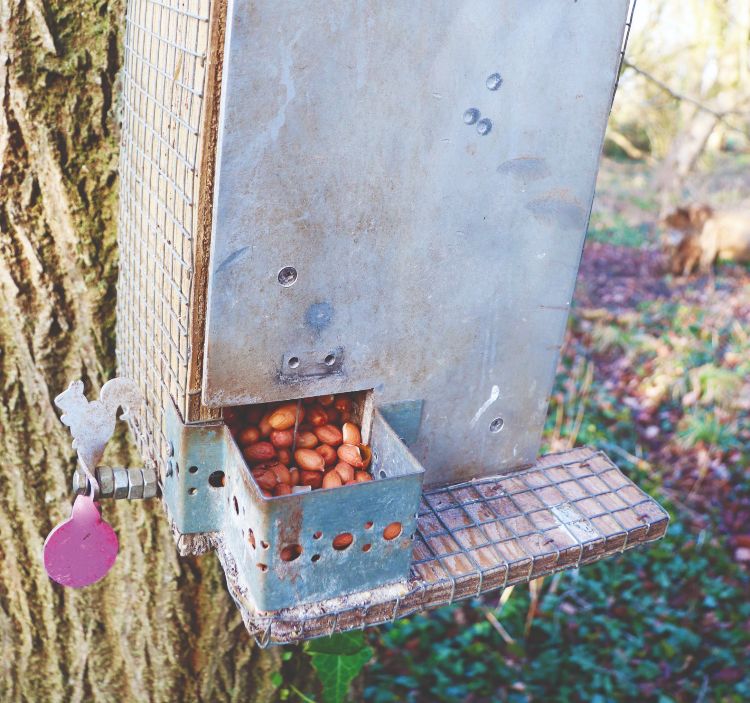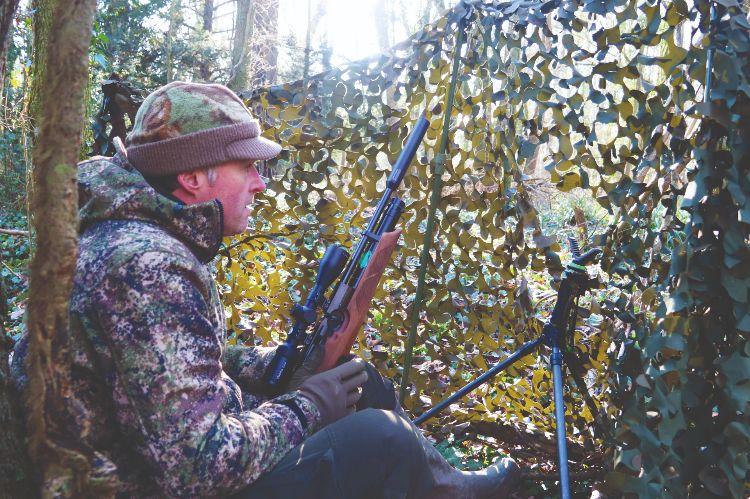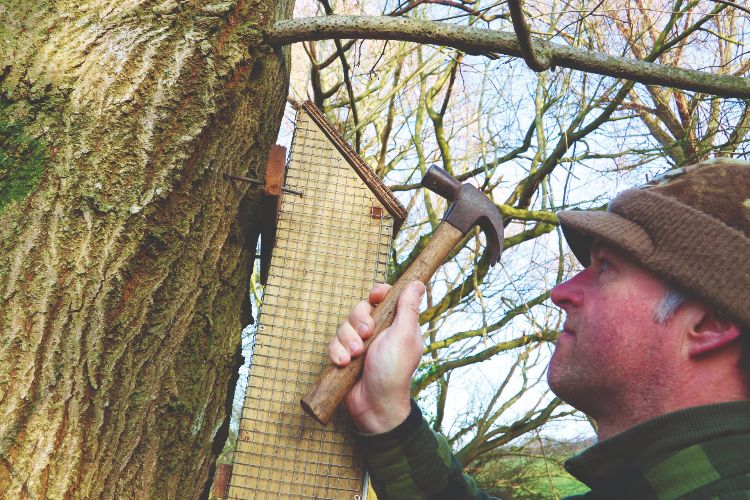 Nothing has boosted my success with grey squirrel control as much as the use of feeding stations. It is a method I began to employ about ten years ago, and the results were phenomenal; rather than shooting one or two squirrels in an outing, I was suddenly nailing eight or nine, and often getting bags into double figures. Consequently, woods that were previously yielding a few dozen squirrels per year were suddenly giving me returns of over 200 in the same time frame. It doesn’t take long for numbers to start to decline when you’re hitting the greys that hard, and that’s what it’s all about when you’re tasked with the control of this destructive pest.
Nothing has boosted my success with grey squirrel control as much as the use of feeding stations. It is a method I began to employ about ten years ago, and the results were phenomenal; rather than shooting one or two squirrels in an outing, I was suddenly nailing eight or nine, and often getting bags into double figures. Consequently, woods that were previously yielding a few dozen squirrels per year were suddenly giving me returns of over 200 in the same time frame. It doesn’t take long for numbers to start to decline when you’re hitting the greys that hard, and that’s what it’s all about when you’re tasked with the control of this destructive pest.
Given the damage that grey squirrels cause to trees – diminishing their timber value and compromising their habitat value for other wildlife – not to mention the negative impact this alien species has had on our native red squirrel and woodland fauna as a whole, we need to be clear that our aim is to reduce their numbers as much as possible. The ultimate goal is eradication, which is never going to be easy in areas where they have a real foothold – but that shouldn’t prevent us from trying.
In my experience, wandering the woods in hope of bagging a grey or two will help to reduce the resident population, and the damage it causes, but it is unlikely to have a significant or lasting impact. What is really needed is a heavy and sustained cull, and feeding stations make that a lot more achievable.
 HONEY TRAP
HONEY TRAP
The great thing about setting up feeding stations for grey squirrels is that they create a ‘honeypot’ area where you can expect to encounter them. Add a trail camera to the equation and you can also work out when squirrelly activity is at its busiest. Now you know where and when you are most likely to encounter squirrels on your patch, and this knowledge will enable you to make optimum use of your time. Other benefits of feeding stations include being able to lure squirrels out to where they offer a clear, static target over a predetermined distance. You’ll be shooting from a comfortable sitting position, very likely with some form of gun support, so the risk of wounding your quarry with a misplaced shot is virtually zero. As a result, this method of control is not only very effective, but also humane because clean kills are practically guaranteed.
You can buy ready-made feed hoppers, but it’s easy enough to make your own – think along the lines of a bird box with a hole at the front that allows your offerings to spill out into a shallow tray. The box needs to be strong enough to survive frequent gnawing by squirrels, as well as pellet strikes, and you need to incorporate a means of attaching it to a tree. Some landowners will want you to use rope, whilst others will be happy for you to nail your feeders up. If you do opt for nails, please make sure that they are all removed when you take your feeder down. I used to work as a chainsaw operator, so I know all too well about the hazards posed by pieces of metal lurking in trees.
 BEST BAITS FOR SQUIRRELS?
BEST BAITS FOR SQUIRRELS?
Ideally, you want to set up your feeder in an area where you know squirrels are present, and in a spot where you can see it easily from wherever you intend to position your hide. I try to attach my feeders high enough to keep them out of the way of inquisitive deer, but low enough to be able to refill them without too much strain.
Shooters have different ideas about the best baits to use in feeding stations, but I rate peanuts above all else because they tend to attract squirrels from far and wide, even when there are other food sources nearby. The only downside is that peanuts are expensive – the best deals are usually to be found online and, if you are very lucky, the landowner may even be willing to contribute towards the cost.
After positioning and filling a feeder, I leave it alone for four or five days before returning to check on it. What usually happens is that birds will home in first, and then their comings and goings will attract the attention of greedy grey squirrels. On returning to the feeder, you should find its contents partly depleted, so if your feeding station appears to be receiving very little or no attention after a week or ten days, it’s probably in the wrong place and will need to be moved to another spot.
All being well, though, squirrels will have moved in and the ground beneath the feeder will be littered with the peanut husks they have stripped and discarded. This is your cue to go ahead and build a hide within comfortable shooting distance. I then usually leave the hide in situ for another week or so before I start shooting. This period gives squirrels time to grow accustomed to the presence of the hide, whilst their constant activity attracts more and more bushy-tailed diners to the banquet.
 ‘FREE’ FEEDING STATIONS
‘FREE’ FEEDING STATIONS
If everything goes to plan, your first ambush should be a good one, and you won’t need to do much more than sit patiently and pick off squirrels as they arrive to dine. Remember to top up the feeder when you finish, and try not to let it run empty between sessions, otherwise there is a risk of squirrels backing off and moving on to another food source if yours becomes unreliable.
I spoke earlier of the expense of peanuts, and there are other options; maize and sunflower seeds work well, and wheat can be effective during periods of cold weather. If you are operating in woods that are managed for game shooting, you may even be able to take advantage of feeding stations that cost you nothing at all.
Gamekeepers usually deploy dozens of grain-filled drums to nourish their pheasants and stop them from wandering. Apart from sustaining gamebirds, these feeders also provide a valuable food source for other wildlife, including grey squirrels. The last thing any ‘keeper wants is squirrels munching through expensive feed and chewing through plastic hoppers, so they are likely to appreciate your assistance in controlling them.
Some ‘keepers may prefer you to leave their pheasant feeders undisturbed during the game-shooting season, but most will be glad for you to operate around these ready-made feeding stations now that it has drawn to a close. On most shoots, the number of active feeders will gradually reduce as spring progresses. This can create some really productive hotspots as more and more squirrels become concentrated around the remaining sources of grain.
My approach around pheasant feeders is much the same as when staking out my own feeding stations. Sometimes, the squirrels are so distracted by the easy pickings that natural cover will be enough to keep you hidden, although I will go to the trouble of building a hide if I identify a feeder that is attracting a lot of squirrels.
 CAREFUL PREP’
CAREFUL PREP’
As ever, patience is usually rewarded. Careful preparation is vital because it’s so much easier to take accurate, decisive shots if you’ve made yourself comfortable and worked out ranges before your quarry makes an appearance.
Grey squirrels tend to keep quite regular hours. As previously mentioned, a trail-cam set up close to a feeding station can help you to work out when their visits are most frequent. This kind of surveillance tech’ is far from essential, though. By and large, squirrels feed hardest at each end of the day; these periods usually occur for a couple of hours after sunrise and then as dusk approaches.
Everyone has their own personal preferences, but these are the techniques that have worked best for me when using feeding stations for grey squirrel control. If you haven’t tried this method before, do give it a go – it could well bring a serious boost to your efforts to bring this destructive pest to book.
MAT’S KIT BAG